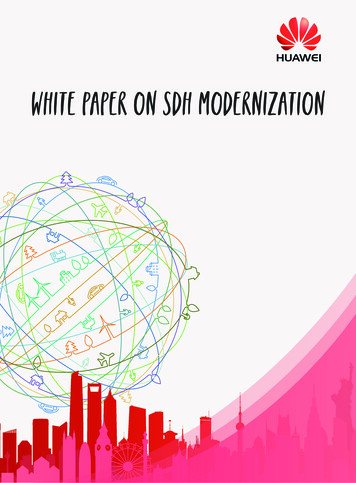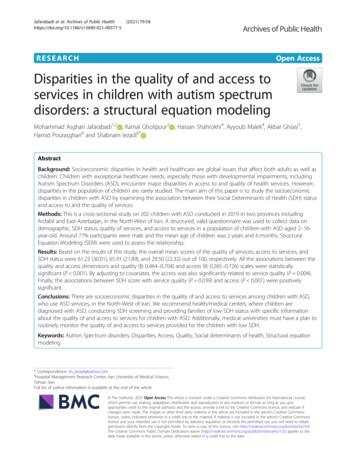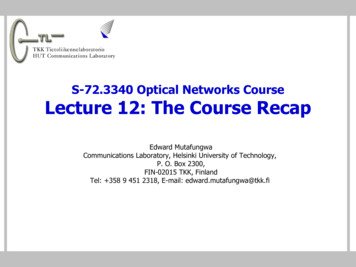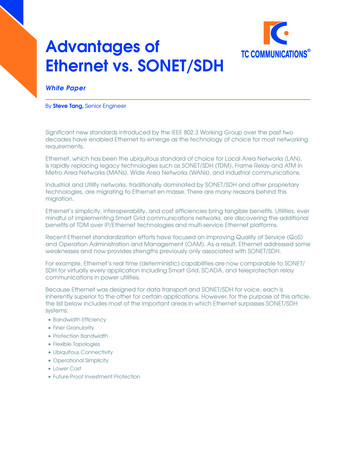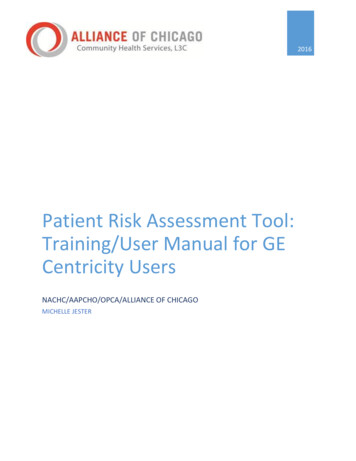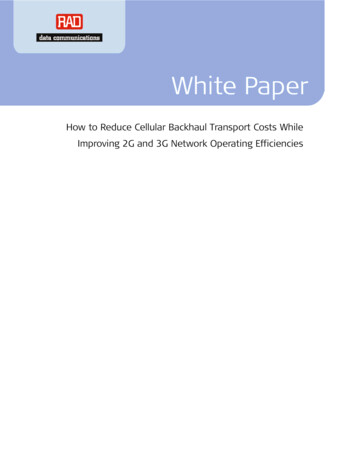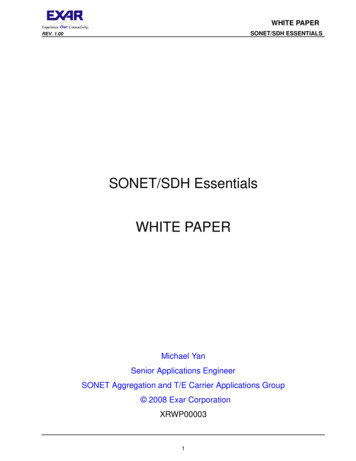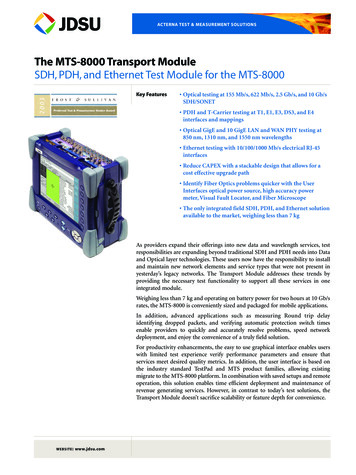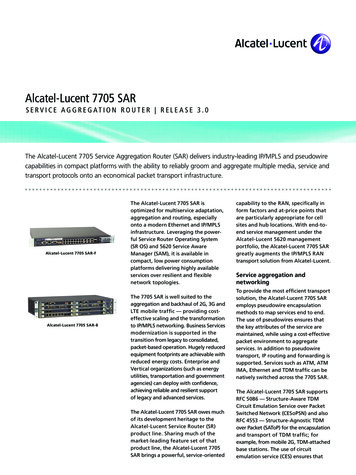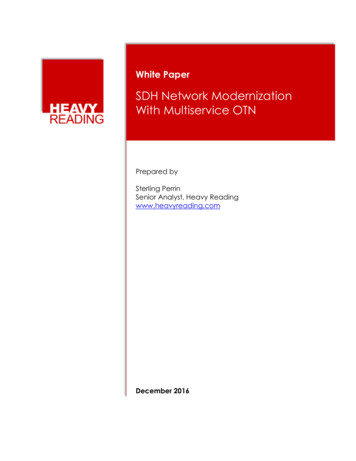
Transcription
White PaperSDH Network ModernizationWith Multiservice OTNPrepared bySterling PerrinSenior Analyst, Heavy Readingwww.heavyreading.comDecember 2016
This white paper is a special report sponsored by HuaweiTechnologies Co. Ltd.Introduction: State of the Sonet/SDH MarketThe end of Sonet/SDH was prematurely declared by the telecom industry so manytimes over the past 20 years that, when the fall of Sonet/SDH did truly commence inearnest, it went largely unnoticed and unheralded.The global Sonet/SDH market peaked in 2000 at 20 billion in revenue. During themid-2000s, Sonet/SDH started on a relatively modest and uneven descent. From2000-2010, Sonet/SDH spend was in decline, but it also benefitted from the relativeimmaturity of the Ethernet technologies that were developed to supplant it. It wasduring this time that many predictions of Sonet/SDH's demise proved premature.However, the Sonet/SDH decline started accelerating rapidly in 2011, when operators embarked on a rapid migration to Ethernet and WDM at the expense of legacySonet/SDH. A significant milestone was hit in 2013, when converged packet-opticaltransport system (P-OTS) spend exceeded Sonet/SDH spend for the first time in history. And by 2015, Sonet/SDH equipment spend – once the 20 billion workhorse ofthe global public network – had fallen 95 percent from its 2000 peak. (See Figure 1.)Figure 1: SDH vs. Packet-Optical Transport Revenue (2000-2015) 25Billions 20SDH 15POTS 10 5 02000200520102015Source: Heavy ReadingThe fall of Sonet/SDH took much longer than most predicted, but today, no one canquestion that the Sonet/SDH era is nearing its final years.Operators Must Move Beyond SDHThe current state of Sonet/SDH creates significant challenges for operators. As noted,global spend on new Sonet/SDH was less than 1 billion in 2015 and continues todrop, but this statistic does not take into account the installed base of Sonet/SDHHEAVY READING DECEMBER 2016 WHITE PAPER SDH NETWORK MODERNIZATION WITH OTN2
equipment that remains operational today. For example, operators spent 16 billionon Sonet/SDH over the last six years alone. And many operators have Sonet/SDHequipment in their networks going back 15 years or longer, much of it supportingTDM private line services.This installed Sonet/SDH equipment is aging, meeting or exceeding the 10- to 15year lifespan for which it was intended. Replacing aging equipment and parts isbecoming increasingly difficult and will ultimately become impossible, as equipment suppliers are no longer investing in a market segment that has lost 95 percentof its value. In a segment that has undergone significant consolidation over theyears, some suppliers have gone out of business.The result is that operators maintaining aging infrastructure cannot get new features, have limited or no access to spare parts, and cannot get service on installedgear. In addition, operators see opex go up due to increased faults and servicedegradation, complex provisioning, high power consumption and large footprint,and the requirement to maintain separate networks: one for newer packet servicesand another for legacy Sonet/SDH services.Ultimately, there are two scenarios that force operators to modernize their Sonet/SDH networks: Operators are no longer able to obtain the parts or systems required tokeep their legacy networks running. Operators find that the opex of running and maintaining their legacy network exceeds the capex of deploying a new replacement network.For operators that need to modernize their legacy Sonet/SDH networks, there aretwo major technology options available: Pure Layer 2/3 packet switching Multiservice switched OTNThe remainder of this white paper explores the major migration options and focusesparticularly on the drivers for and benefits of Sonet/SDH migration with multiserviceswitched OTN.SDH Migration to Layer 2/3 Packet SwitchingOne of the options for operators migrating away from Sonet/SDH transport is to movedirectly to packet-based transport using carrier-grade Layer 2/3 switches. A numberof technology advancements over the past decade has made Layer 2/3 switching asuitable replacement for Sonet/SDH in a number of applications, and particularly forapplications that are exclusively or primarily carrying Layer 2 and Layer 3 traffic.Mobile backhaul is an application in which packet switching equipment has excelled. The global migration away from TDM-based backhaul to packet-basedbackhaul occurred over the past six years. In 2010, just 9 percent of cell sites globallywere served by Ethernet backhaul (with the remaining 91 percent served by TDM),according to Heavy Reading. At the end of 2015, 79 percent of global cell siteswere served by Ethernet-based backhaul networks.Increasing bandwidth requirements for 3G and 4G, combined with the maturationof technologies that addressed historical packet network shortcomings, were theHEAVY READING DECEMBER 2016 WHITE PAPER SDH NETWORK MODERNIZATION WITH OTN3
main contributors. The ITU-T Synchronous Ethernet and IEEE 1588v2 synchronousstandards were critical for packet backhaul. Packet synchronization surpassedE1/T1 synchronization in 2012.Circuit emulation services (CES) was another key advancement that enabled operators to run their TDM services over packet networks. This advancement was importantfor converged infrastructure applications in which operators wanted to run bothpacket and TDM services over the same network. CES, once it matured, has proveneffective for networks that are predominantly packet-based with a limited amountof TDM services that can be carried via CES.Carrier Ethernet services is another application in which packet switching equipmenthas fit well. In the early days of Ethernet, operators required Ethernet services totravel over Sonet/SDH networks due to reliability requirements (i.e., EoS or EoSDH)and OAM features provided by Sonet/SDH, which Layer 2/3 switches lacked. However, carrier-grade reliability and Ethernet OAM functionality – including ITU-Ty.1731 – made packet switching suitable for many Carrier Ethernet applications.Limitations of Packet SwitchingDespite technology progress over the past decade, packet switching also haslimitations that make it unsuitable for many applications that continue to rely onSonet/SDH. Below is a summary of the primary limitations of packet switched networks compared to Sonet/SDH. Layer 2/3 switching introduces high latency relative to Sonet/SDH that maymake it unsuitable for applications that are highly latency-sensitive or havestrict requirements for latency guarantees. Latency in packet switched networks is unpredictable and cannot always be guaranteed. CES is only an option for lower-capacity circuits, as the technology is limitedto T1/E1 and T3/E3 rates. Sonet/SDH set the gold standard in reliability with "five nines" uptime andsub-50 millisecond recovery times. Despite its advances, packet switchingcannot match the ultra-high reliability of Sonet/SDH networks. Shared packet-switched networks are not private like dedicated circuitswitched Sonet/SDH networks, and certain operators and enterprise customers require the security of a private, dedicated connection. Finally, some high-value end customers are simply not willing to move awayfrom their TDM services, and forcing a migration to packet-based networksrisks losing these customers.Sonet/SDH Migration With Multiservice OTNWhile packet switching has evolved to take on a portion of the burden of legacySonet/SDH, it is not always the best option. This section takes a detailed look at another strong option for SDH network migration: multiservice OTN. Multiservice OTNcomprises two key features: The bit-rate transparency of OTN encapsulated signals, Universal switching fabrics that can switch all kinds of service types, including TDM- and packet-based services.HEAVY READING DECEMBER 2016 WHITE PAPER SDH NETWORK MODERNIZATION WITH OTN4
We describe both of these multiservice OTN features in more detail below.Bit-Rate TransparencyOTN is an optical transport standard developed by the ITU-T and first standardizedin 1998. It is also known as ITU G.709 and "digital wrapper." While G.709 is the mostnotable ITU-T standard associated with OTN, other relevant ITU-T standards includeG.873.1 and G.872. In OTN, the ITU defined a payload encapsulation, OAM overhead, FEC, and multiplexing hierarchy. The result is a transport standard that includes the benefits of Sonet/SDH (such as resiliency and manageability), but withimprovements for transporting data payloads.OTN is asynchronous, and so does not require the costly and complex timing thatSonet/SDH requires. Yet OTN is a transparent protocol, so it can carry asynchronoustraffic such as Gigabit Ethernet, synchronous traffic such as Sonet/SDH, and even amixture of synchronous and asynchronous, without interfering with the OAM of theclient traffic itself.This bit-transparent transport of the client signal is commonly referred to simply as"transparency." Note that OTN transport is also timing-transparent. OTN's asynchronous mapping transfers the input signal timing to the far end of the connection. Thisis in contrast to Sonet/SDH, which imposes its own timing on client signals.Universal SwitchingA protocol-agnostic, or universal, switch fabric can process any type of TDM orpacket traffic natively, without requiring protocol encapsulation. There are differenttechnologies used for universal fabrics, including TDM-based and cell-based fabrics.These different technologies manipulate the bits differently while they are passingthrough the fabric chip itself. However, in all instances of a universal fabric, the endfunction is the same: Traffic entering the switch (whether it is Ethernet, Sonet/SDH,OTN, etc.) exits the switch in the same format. A key benefit is that different servicetypes and different bandwidth granularities can be encapsulated within the sameOUT-k channel, which increases bandwidth utilization.Universal switching fabrics are an important tool in achieving transport network element convergence. Traditionally, operators have deployed multiple boxes to handleseparate functions of DWDM transport, Layer 1 circuit switching, and higher-layerpacket switching. These have all been managed separately and connected viashort-reach interfaces. A converged network element eliminates multiple boxes in acentral office and creates capex and opex savings, while also simplifying management. This converged structure is especially efficient in some scenarios, including: Networks in which the aggregation and access equipment are 10GigEwhile the core router is upgraded to 100GigE. Very short time to market for end-to-end dedicated line services since thereis no need for a UNI connection for different layers. This reduces patch cordsand labor.Universal fabrics make converged transport systems more efficient by covering allswitching options on day 1 of deployment, and by allowing operators to changethe mix of fabric use from TDM to packet over time easily and without additionalfabric card investments.HEAVY READING DECEMBER 2016 WHITE PAPER SDH NETWORK MODERNIZATION WITH OTN5
Figure 2 illustrates a multiservice OTN network using a centralized universal switchingfabric combined with universal line cards that carry any service type – includingSonet/SDH, OTN, and packet-based services.Figure 2: Universal Switching Fabric Carrying Multiple Traffic TypesSource: Huawei and Heavy Reading, 2016Primary Benefits of Multiservice OTNOTN brings several benefits to operators that are looking to migrate away fromlegacy Sonet/SDH networks. Below we discuss the primary advantages of multiservice OTN transport and switching, as well as several applications that are bestsuited to those advantages.Guaranteed & Ultra-Low LatencyNetwork latency is any kind of delay that occurs in data communications over anetwork. Latency in transmission has many sources, including hops through the various elements along a route and the transmission medium itself.Latency over optical fiber is ultimately dictated by the speed of light travelingthrough that fiber and the distance over which the signal travels. Photonic devicesalong a fiber route – including fiber amplifiers and photonic-layer switches – eachadd latency to a transmission, but it is minimal, measured at 5 ns per device.Beyond the photonic layer, higher-layer processing is required in optical transmissions for functions including OAM, multiplexing and grooming, and switching. Here,Layer 1 is always the best choice from a latency and overhead perspective. As aLayer 1 protocol, OTN adds very little overhead and latency to transmissions compared to Layer 2 Ethernet and Layer 3 IP networking protocols. Layer 1 switchingprovides up to 1,000 times lower latency than Layer 2 switches or Layer 3 routers,and also guarantees full line-rate performance with no oversubscription.HEAVY READING DECEMBER 2016 WHITE PAPER SDH NETWORK MODERNIZATION WITH OTN6
In addition to low latency, OTN also provides a high consistency of latency acrossdifferent data rates, as well as high consistency across different client protocols,such as Gigabit Ethernet or Fibre Channel, for example.In addition to the amount of network latency in a transmission, the variation in latencyis another important factor that operators must consider in offering services. TDMnetworks – which includes Sonet/SDH and OTN networks – create fixed latency inthe transmission, which is also guaranteed for the operators and for their end customers. Guaranteed and predictable latency is important for high-value services,such as leased lines, and for certain applications, such as video.By contrast, Layer 2 (Ethernet) and Layer 3 (IP) packet networks not only havegreater latencies, due to greater processing, but latency is also unpredictable. Variability in latency is a problem in packet switched networks particularly during peaktraffic times, during which latency can increase to 10 times to as much as 100 timescompared to low traffic times.High Scalability With Guaranteed BandwidthTwo key aspects make OTN highly scalable when compared to legacy Sonet/SDH.The first relates to 100G transmission. While both Sonet/SDH and OTN standards existat 2.5G, 10G, and 40G data rates, there is no 100 Gbit/s standard for Sonet/SDH. Ofthe two protocols, only OTN has been standardized up to 100 Gbit/s transmission(ITU-T OTU4). For this reason, OTN switching took off in the core network when operators began migrating to 100G, and as 100G has started moving into metro applications, we are seeing concurrent adoption switched OTN in metros.Second, OTN signals ride on DWDM wavelengths, so OTN is scalable at the DWDMlevel. This makes OTN suitable for high-bandwidth applications are that also highgrowth applications, such as financial trading applications and high-definition videosuch as HDTV and 4K video. For these applications, as bandwidth needs increase,operators can quickly upgrade capacity by adding an additional OTN-based wavelength on the existing system.Beyond scalability, an additional benefit of OTN is guaranteed bandwidth. As aconnection-oriented, TDM-based protocol, OTN inherently also provides guaranteed bandwidth for end customers, meaning that a customer that orders a 10 Gbit/sservice over an OTN network will always receive a 10 Gbit/s signal. This can be particularly important for private line customers, and for wholesale customers who arepaying for a set amount of capacity and need to be assured that they will alwaysreceive exactly what they are paying for.High SecurityTwo aspects make OTN an ideal fit for operators that require high security. First, OTNover DWDM enables operators to dedicate a full channel/wavelength for individualcustomers. Thus, an end customer can put all of their traffic on a private wavelength(or multiple private wavelengths) without sharing capacity with other customers.The second security benefit of OTN is Layer 1 encryption. Layer 1 encryption securesdata as it travels between end locations, such as between two data centers, orbetween a data center and an enterprise location. Encrypting Layer 1 for the inflight portion of a transmission ensures that information contained in all of the layersabove Layer 1 is also encrypted. This is because the encrypted payload of a LayerHEAVY READING DECEMBER 2016 WHITE PAPER SDH NETWORK MODERNIZATION WITH OTN7
1 OTN frame contains all of the payload and header information of every layer thatis being carried over that wavelength.Layer 1 encryption also has benefits of extremely low latency compared to higherlayer encryption techniques. For example, 100G optical encryption adds less than 150nanoseconds of latency to a transmission, whereas a 10 Gbit/s Ethernet transmission adds several microseconds (while providing one tenth the bandwidth). IPsecencryption adds even greater latency, measured in milliseconds – roughly 10,000times greater latency compared to OTN encryption.Highest levels of data security are a requirement for government applications, aswell as for financial services applications. Enterprises across verticals are becomingincreasingly concerned with data breaches, so security is really a growing requirement across industries.Figure 3 provides a summary of certain verticals and applications across the keyattributes of OTN that were discussed in this section.Figure 3: Requirements for hGovernmentMEDIUMMEDIUMHIGHHIGHMEDIUMFinancial servicesHIGHHIGHMEDIUMHIGHHIGHPrivate eoHIGHHIGHHIGHHIGHSource: Heavy ReadingSmooth Network MigrationLastly, a smooth migration is one of the most important requirements for anySonet/SDH network modernization project. If the migration is not carefully executed,there will be service interruptions due to incompatibility between the new networkand the old Sonet/SDH network. Here, the MS-OTN universal switching fabric provides an advantage by enabling a site-by-site migration from the old Sonet/SDH.The MS-OTN equipment can support all Sonet/SDH services and can fit in the oldSonet/SDH network without requiring changes to other sites. With MS-OTN, potentialmistakes can be located easily and service interruptions can be avoided.Migrations using IP and other packet-based equipment, by contrast, are more complex. Typically, in these cases, a new packet network must be built before theSonet/SDH offload takes place, requiring extra fiber and space for the new sites andintroducing risks for service interruptions and delays.Some vendors propose a third option – a mixed network that consists of both SDHequipment and separate, switched OTN elements. This option is proposed by vendors that don't have multi-service capabilities within their OTN systems. However, thisarchitecture also raises compatibility issues between the new network and the old.HEAVY READING DECEMBER 2016 WHITE PAPER SDH NETWORK MODERNIZATION WITH OTN8
We close this white paper with a look at four network operators from different regions of the world that faced various challenges with their aging SDH networks andultimately selected multiservice OTN for their SDH modernization. Figure 4 highlightsthese SDH modernization success stories.Figure 4: Operator SDH Modernization Success StoriesOperatorChallenges & RequirementsMultiservice OTN BenefitsTier 1Operator,AmericasSDH equipment from more than 10vendors, with some equipmentreaching end of life. Resource systemwas more than 20 years old and 30percent inaccurate. Operator wasalso running out of CO space.Migrating to multiservice OTN, operatorwas able to reduce opex by 20 percentand reduce CO space by 40 percent.Operator also improved network restoration times and simplified networkplanning.Tier 1Operator,India3G subscribers increasing rapidly, butlegacy SDH network was unsuitablefor 3G/LTE migration. SDH requiredhigh opex, a large number of fibers,and provided limited bandwidth.Operator reduced capex by 55 percent, and each single site was givenexclusive bandwidth that did notaffect other sites.Tier 1Operator,EuropeMassive network of old SDH equipment, entering end of life, with frequent faults, lack of spare parts andhigh power consumption. LegacySDH network provided insufficientbandwidth for growth requirementsand was too costly.Multiservice OTN saved 70 percent ofCO floor space and reduced powerconsumption by 60 percent comparedto legacy SDH network. Also, only 10percent of the original SDH networkinvestment was required to updatethe network with multiservice OTN.Tier 1Operator,EuropeMore than 9,000 sets of SDH equipment from multiple suppliers, andmuch of it more than 10 years old.Operator faced high opex, high rent,high power consumption and lowOAM efficiency.Migrating to multiservice OTN savedmore than 35 percent on both capexand opex compared to legacy network. Operator also increased capacityand scalability, enhanced service availability and improved OAM efficiency.Source: Huawei, 2016ConclusionThe current state of Sonet/SDH is creating a major challenge for major operatorsglobally. For the past decade and longer, operators have been building outpacket-centric networks to support the rapid growth in in data traffic and serviceson their networks. Equipment suppliers responded to operator demand by refocusing their R&D and investments on packet network equipment, while eliminatinginvestments in and support for legacy Sonet/SDH.The problem today is that many of the services remaining on legacy Sonet/SDH networks – such as high-value and high-availability leased line traffic – are unsuitablefor a packet network migration. Compounding the problem is the fact that muchof the Sonet/SDH infrastructure is past its intended lifespan and in need of replacement now.HEAVY READING DECEMBER 2016 WHITE PAPER SDH NETWORK MODERNIZATION WITH OTN9
Enter multiservice OTN as the solution for migrating these high-value, high-availabilityapplications from the aging Sonet/SDH networks on which they operate withoutsacrificing the features that are needed. Heavy Reading believes that multiserviceOTN offers the following key benefits for SDH modernization: Predictable latency that can be guaranteed for network operators, and fortheir end customers Ultra-low latency from Layer 1 transport that can be orders of magnitudelower than Layer 2 and Layer 3 networks Ultra-high scalability from WDM that can deliver 200 Gbit/s per channeltoday and 80 channels or more per fiber High security from dedicating separate OTN channels to each customer,combined with the ability to encrypt all in-flight traffic at Layer 1 The ability to efficiently combine legacy Sonet/SDH, OTN and packet trafficon a single network infrastructure using the universal switching fabric in multiservice OTN equipment. The ability for operators to migrate their customers away from TDM privatelines at a pace that is comfortable for those customers, and without forcingon customers a drastic change.Heavy Reading believes that these features, in combination, make multiservice OTNa compelling choice for operators facing SDH modernization.HEAVY READING DECEMBER 2016 WHITE PAPER SDH NETWORK MODERNIZATION WITH OTN10
HEAVY READING DECEMBER 2016 WHITE PAPER SDH NETWORK MODERNIZATION WITH OTN 3 equipment that remains operational today. For example, operators spent 16 billion on Sonet/SDH over the last six years alone. And many operators have Sonet/SDH equipment in their networks going back 15 years or longer, much of it supporting
